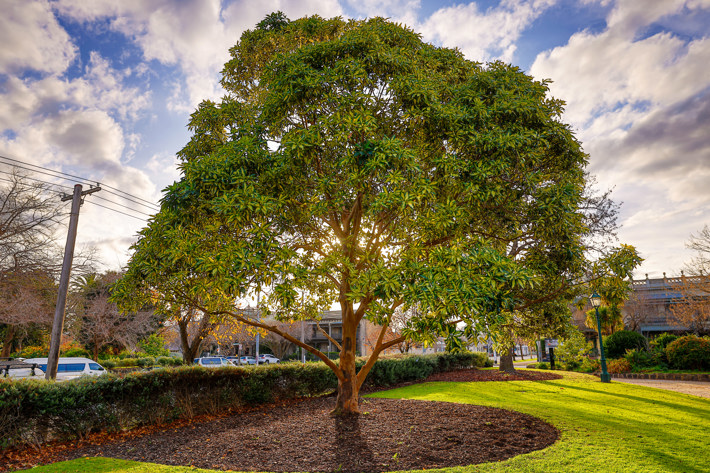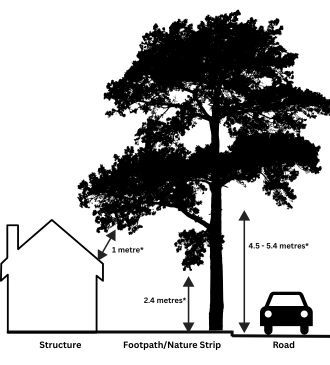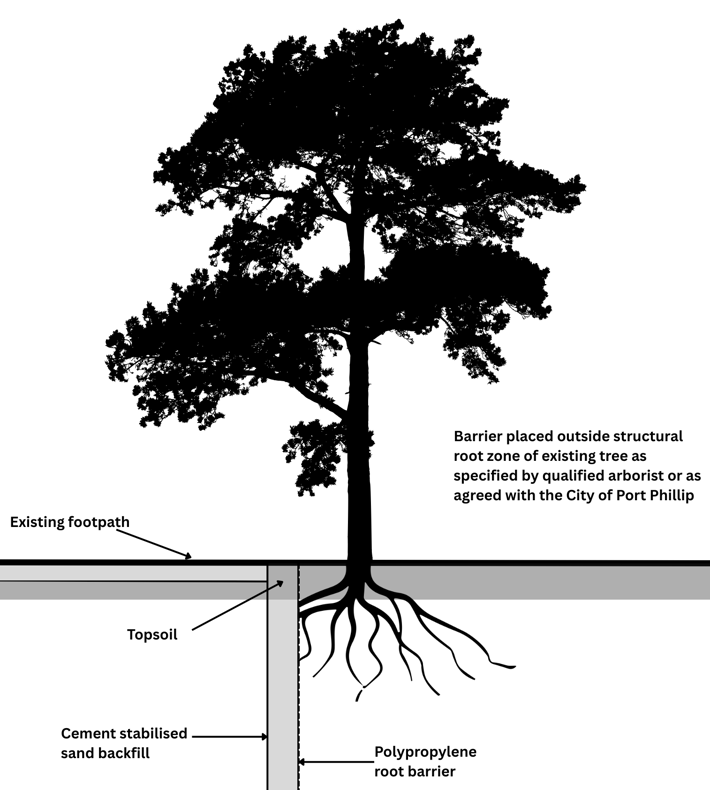Trees

Council is responsible for maintaining over 46,000 trees throughout the municipality. Our primary maintenance focus is gaining proper clearance spaces for Electrical Line Clearance and Road Management obligations. Council’s arborists assess each tree on a cyclical basis - more information can be found on our routine maintenance page. If any works are needed to meet our service obligations, they will be scheduled into our ongoing works program. Our team of passionate, highly qualified arborists handles the assessment and maintenance of our thriving urban forest. Our tree management program is guided by the Greening Port Phillip Policy and Urban Forest Strategy.
Reporting a tree hazard
If you see a tree or branch blocking a road or footpath, please call our friendly ASSIST team on 03 9209 6777 as soon as possible.
For non-urgent requests let us know on My Port Phillip, or via Snap Send Solve. It’s always helpful for our trees team if you include a photo of the tree and the exact location in your request.
Tree Trimming and Pruning
Council manages over 46,000 trees and maintains these as part of a scheduled program. Outside of this schedule, we will only prune if there is an urgent need, like a tree or branch blocking a road or footpath or a risk to public safety. In general, we prefer to do as little pruning as possible, while ensuring the safety and amenity of residents. This is because pruning can cause irreversible damage to the tree.
If you log a tree pruning request for a tree that is scheduled for inspection or pruning in the next six months and not considered high risk, the works will be carried out in the scheduled works timeframe.
We consider pruning trees for:
- Clearance from roads and footpaths, as required by Road Management and Disability Discrimination Act.
- Removal of deadwood over 25mm in diameter, and any branch stubs or diseased, dying, defective, crossing, broken or hanging branches.
- Reduction from dwellings and other buildings. This does not include removal of all tree parts over a building or back to a property line. Works of this type are considered on a case-by-case basis.
- Clearance for electrical assets as required by Electrical Line Clearance regulations.
- All works conform to Australian Standard 4373 – Pruning of Amenity Trees.

*Distances are approximate and dependent on location of tree. Works are considered on a case-by-case basis.
We do not prune trees:
- For reduction of foliage to reduce leaves and fruit falling into private property.
- For reduction of foliage to increase sunlight onto private property, including for solar panels or similar.
- To remove or reduce roosting perches to decrease habitat for fauna (birds, possums etc.), or to reduce the appearance of droppings or other animal mess.
- To reduce fauna access between trees or infrastructure.
- To manage insect populations or debris associated with insect populations.
Make a Request for pruning on My Port Phillip, over the phone on 03 9209 6777 or via Snap Send Solve. For a faster response, please include photos and the exact location of the tree.
Tree Roots
Our dedicated team of qualified arborists manages the urban forest in accordance with the Urban Forest Strategy. Assessing and maintaining street trees can be complex, particularly when addressing root management through root pruning or the installation of tree root barriers to protect public and private assets.
Tree root work can be invasive, so to safeguard the tree health and community safety, we only undertake major tree root treatment during the cooler months, suspending all but the most urgent work for three months during summer. This preserves the tree's vital root functions, especially during hot, dry summers when trees are at risk of drought stress due to rapid soil moisture evaporation.

Disclaimer: Tree Root Barriers: The information provided regarding tree root barriers is for general informational purposes only and should not be considered as professional advice. The effectiveness of tree root barriers may vary depending on the specific species of tree, soil type, climate conditions, and installation methods. Always consult with a qualified arborist, landscape professional, or relevant expert before undertaking any landscaping projects involving tree root barriers. Proper installation and maintenance are crucial for achieving the desired results, and failure to do so may result in damage to property, underground utilities, or the health of the tree. The user assumes all responsibility for any risks or outcomes associated with the use of tree root barriers.
Tree Roots and Drains
Tree roots are opportunistic and move through the soil profile where conditions are conducive to growth. Roots have no means of sensing water within pipes and actively seeking it. If there is a leak in the pipe, roots may exploit and exacerbate the opening – sometimes causing pipe blockages. Council highly recommends property owners ensure their drains are properly maintained to avoid damage.
Relining or replacing drains is an effective method of avoiding the ongoing costs of having drains cleared regularly.
Following completion of drainage works, a property owner may make a claim for compensation from Council if they believe Council is at fault.
Private stormwater drains (Legal Point of Discharge) are the responsibility of the property owner to repair, maintain or replace. We do not repair, unblock or clear private stormwater drains.
Tree Planting
City of Port Phillip Tree Planting Programs
As part of Port Phillip’s implementation of the Urban Forest Strategy, Council plants a large number of trees per year. Our tree planting program takes place between April to October each year. This is because young trees are more likely to successfully become established during the cooler, wetter months. All trees planted during this period are placed on a monitoring schedule to ensure they receive the support they need to reach maturity.
Street tree planting in Port Phillip involves three different programs within a street or street section:
- In-fill planting – planting out with the same or a similar species
- Partial renewal – removal of inappropriate trees or trees in ill health, with in-fill planting to reinforce a preferred tree species. This program may also include the construction of new or improved planting sites, such as in-road planters or expanded sites in areas with hard surfaces.
- Renewal – removal of most, if not all, inappropriate or declining street trees with replacements of a more appropriate species. This program may also incorporate the creation of new or improved planting sites.
We proactively plant trees on nature strips, parks, reserves and other Council-owned land to:
- Increase canopy to achieve a greener, cooler and more liveable city
- Increase the number of trees within our streets
- Preserve and enhance the local character of the distinct areas which make up our city
- Provide biological diversity. This can include both native and exotic species, as both contribute to biodiversity which helps protect our urban forest from diseases that affect a particular tree genus or species
What happens when you request tree planting?
A qualified arborist will assess the site for suitability and place your request on our centralised planting list. As we approach planting season, we will order the trees and conduct planting as part of the programmed works. You may request planting at any time of the year, however, requests received after 30 June may not be completed until the following year’s planting season, to ensure enough time to source quality tree stock.
How do we select trees?
There is no perfect, one-size-fits-all urban tree. The urban environment is a varied collection of microclimates and soil conditions, both of which can vary dramatically within the space of a few metres.
Because of this, site analysis is conducted for each major planting site, to allow for the selection of the most appropriate tree species.
When selecting trees, we consider the following:
- Suitability of the tree for the site
- Surrounding planting themes
- Adaptability to climate change
Watering street trees
Trees depend heavily on water, and the use of grey water from baths, showers and washing machines (using biodegradable detergent) can help trees thrive. This is where residents can help!
It can be difficult to find an appropriate place for watering street trees. Large established trees have a root system that tends to be proportional with the tree’s canopy. The edge of the canopy is known as the drip line. Tree-lovers are encouraged to water these trees on the drip line.
Recently planted trees have been fitted with a watering well. These watering wells allow the water within to penetrate the tree’s root, as this is the most appropriate location for new trees to be watered.
Tree Health and Tree Removals
Have you noticed a dead or dying tree? Is the tree outside your property at risk of dropping a branch? Almost all tree-related requests require an initial inspection before we do any work. This ensures that the work is appropriate, achievable and aligned with the Urban Forest Strategy. Removal of trees is an action of last resort and will only be considered in limited circumstances.
Where a tree is found to be dead, or in a state of advanced decline (dying), Council will look to have the tree removed. Where a tree is found to pose an unacceptable risk of harm to people or property, the part of the tree which poses a risk will be removed. Occasionally, keeping the remaining part of the tree becomes untenable and the remainder will also be removed.
Fusarium Wilt is a serious disease that affects Canary Island Date Palms in Port Phillip. Infected palms need to be removed. You can read more about it on the Palm tree removal (Fusarium wilt) page.
Elm Leaf Beetle is a pest that affects the foliage of Elm trees. Luckily, it is manageable and we treat trees every three years using Silvashield.
For all your tree-related concerns, contact our trees team. We will come out to inspect the tree and provide you with a timeframe for any work required.
The team can be contacted via the following channels:
- Send us a message on My Port Phillip
- Phone: 03 9209 6777
- Use the Snap Send Solve app
Private Trees and Significant Trees
Private Trees
The City of Port Phillip does not provide pruning or maintenance services for trees on private property. These trees are the responsibility of the landowner.
In line with the Local Law, landowners are responsible for ensuring that pedestrian access to paths and traffic sightlines are not blocked by overhanging trees and shrubs. For advice on tree maintenance, or to undertake work on the trees located on your property, please contact a qualified arborist.
If you notice low-hanging branches from a tree on private property blocking a footpath, let us know:
- Send us a message on My Port Phillip
- Phone: 03 9209 6777
- Use the Snap Send Solve app
Our Local Laws team will contact the property owner to request they prune the tree by a specified deadline.
Significant Trees
In Port Phillip, a Significant Tree is any mature tree on private land with a trunk circumference greater than 150cm, when measured at 100cm from the ground.
If your property is home to a Significant Tree, or has a Heritage Overlay, you need to apply for a permit to undertake pruning or removal work.
Visit the Significant Tree Permit page for more information and details about permit applications.
Street Tree Care and Protection
In the City of Port Phillip, we love our street trees. If you are undertaking construction or development in an area where street trees may be affected, we have a set of guidelines to help you ensure these vital public assets are protected from harm.
You can view these guidelines here: City of Port Phillip Tree Protection Factsheet.
If you have any questions about street tree protection in the municipality, please reach out to our Trees and Parks team.
Climate change is expected to bring warmer, wetter winters, warmer drier summers and rates of fire and insect disturbance are expected to increase. In addition, these effects will interact with existing urban stresses such as air pollution, soil compaction and heat island effects.
As our climate progressively changes, our young and stressed trees will take longer to grow and will require more care to stabilise to local conditions and reach maturity.
You can make a difference, by adopting and watering a tree in your street or local area. Water, mulch and soil improvements will all help improve the health of your tree.
If you find a tree that looks stressed, please let us know the location and details.
- Send us a message on My Port Phillip
- Phone: 03 9209 6777
- Use the Snap Send Solve app
Mulching
We apply mulch to the base of trees to help retain soil moisture levels and improve the soil profile. If you would like to mulch a tree on your property, free mulch is available at the South Melbourne Resource Recovery Centre.
More Information
For more tree care tips, please visit:
Contact us
Our Parks and Trees team is here to help.
Send us a message on My Port Phillip
Phone: 03 9209 6777